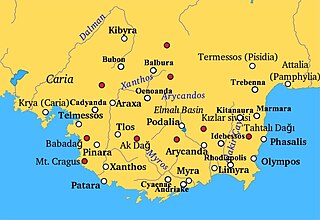Related Research Articles
Calynda was a city in ancient Caria.
Sidyma, was a town of ancient Lycia, at what is now the small village of Dudurga Asari in Muğla Province, Turkey. It lies on the southern slope of Mount Cragus, to the north-west of the mouth of the Xanthus.

Cadyanda or Kadyanda was a town of ancient Lycia. The site was discovered by Charles Fellows. The decree of Pixodarus now in the British Museum shows that the Lycian name of the town was Xadawãti.
Daedala or Daidala was a city of the Rhodian Peraea in ancient Caria, or a small place, as Stephanus of Byzantium says, on the authority of Strabo.

Idebessos or Idebessus, also known as Edebessus or Edebessos or, was an ancient city in Lycia. It was located at the foot of the Bey Mountains to the west of the Alakır river valley. Today its ruins are found a short distance to the west of the small village of Kozağacı in the Kumluca district of Antalya Province, Turkey. The site, 21 kilometres north-northwest of Kumluca, is overgrown with forest and hard to reach.

Apollonia was a city in ancient Lycia. Its ruins are located near Kiliçli (Sıçak), a small village in the Kaş district of Antalya Province, Turkey.

Podalia, also spelled Podalaea or Podalaia (Ποδαλαία), Podallia (Ποδαλλία), and Podaleia (Ποδάλεια), was a town of ancient Lycia, mentioned by several ancient authors.
Choma was a place in the interior of ancient Lycia, according to Pliny on a river Aedesa. Ptolemy places Choma as one of the four cities of the Milyas, and places it near Candyba. The town can be identified with a site near today's village of Hacımusalar in the district of Elmalı.

Nisa, also Nyssa (Νύσσα) or Nysa (Νύσα) or Neisa (Νείσα), was a town in ancient Lycia near the source of the River Xanthus.

The Heroon of Trysa is the modern name for an ancient tomb, built around 380 BCE in Trysa, in ancient Lycia in southwest Turkey. It was discovered in 1841 by the gymnasium teacher Julius August Schönborn during his field research in Lycia.
Hippucome or Hippoukome was a town of ancient Lycia.

Isinda was a town of ancient Lycia. Isinda was part of a sympoliteia with Aperlae, Apollonia and Simena.
Istlada was a town of ancient Lycia; the name is known only from inscriptions and is uncertain because the end of the inscription has been lost.
Lissa was a town of ancient Lycia, mentioned by Ptolemy.
Teimiussa, also spelt Teimioussa or Timiussa, also known as Tristomon, was a port town of ancient Lycia, near the ancient settlement Tyberissus. The name is not attested in history, but is derived from epigraphic and other evidence. This combination of harbor and inland location is the focus of archaeological exploration. Among the finds are ancient tombs.
Tyberissus or Tyberissos, also Tyberisus or Tyberisos, was an inland town of ancient Lycia, near the ancient settlement of Teimiussa that functioned as its port. The name is not attested in history, but is derived from epigraphic and other evidence. This combination of harbor and inland location is the focus of archaeological exploration. Among the finds are tombs with Lycian inscriptions. Coins inscribed "ΤΥ" of typical Lycian type were probably minted here.
Olbia was the westernmost town on the coast of ancient Pamphylia, which some ancient writers place in Lycia. Ptolemy places it between Phaselis and Attaleia. Stephanus of Byzantium blames Philo for ascribing this town to Pamphylia, since, as he asserts, it was situated in the territory of the Solymi, and its real name was Olba; but the critic is here himself at fault, confounding Olbia with the Pisidian Olbasa. Strabo describes Olbia as a strong fortress, and its inhabitants colonised the Lycian town of Cadrema.
Elbessos was a town of ancient Lycia, which was mentioned in a treaty between Caesar and the Lycian League.
Toriaeum or Toriaion was a town of ancient Lycia, inhabited during Roman and Byzantine times. During Roman times it was a Roman colony; during Byzantine times it seems to have appeared in the Synecdemus as Komistaraos.
References
- 1 2 Richard Talbert, ed. (2000). Barrington Atlas of the Greek and Roman World . Princeton University Press. p. 65, and directory notes accompanying. ISBN 978-0-691-03169-9.
- ↑ Stillwell, Richard; MacDonald, William L.; McAllister, Marian Holland, eds. (1976). "Trysa". The Princeton Encyclopedia of Classical Sites. Princeton University Press.
- 1 2 The Princeton Encyclopedia of Classical Sites, TRYSA Lycia, Turkey
- ↑ Lund University. Digital Atlas of the Roman Empire.